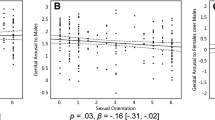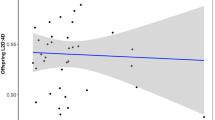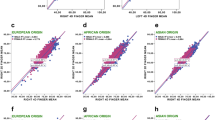Abstract
A proposed marker of prenatal androgen exposure is the ratio of the index finger to ring finger (2D:4D). Within each sex, this ratio may be lower for those who were exposed to higher levels of androgens and become attracted to women, as compared to those who were exposed to lower levels of androgens and become attracted to men. We examined these patterns in identical twins with discordant sexual orientations. Because these twins are genetically identical, differences in prenatal androgen exposure, as reflected in their different finger length ratios, might contribute to their discordance. For 18 female twin pairs, non-straight (bisexual or lesbian) twins had significantly lower, or more masculinized, 2D:4D ratios than their straight co-twins, but only in the left hand. For 14 male pairs, non-straight twins had, contrary to our prediction, more masculinized finger length ratios than straight co-twins, but this difference was not significant. A reanalysis of present and previous data (Hall & Love, 2003; Hiraishi, Sasaki, Shikishima, & Ando, 2012) suggested that these patterns were robust. Furthermore, males had more masculinized 2D:4D ratios than females. This sex difference did not vary by sexual orientation.





Similar content being viewed by others
Change history
11 December 2018
Readers should note that the confidence intervals for the effect of sexual orientation on 2D:4D in the left hand of female twins are incorrectly reported in Table 1 of this article. In particular, the upper limit of the confidence intervals is missing a minus sign.
References
Allaway, H. C., Bloski, T. G., Pierson, R. A., & Lujan, M. E. (2009). Digit ratios (2D:4D) determined by computer-assisted analysis are more reliable than those using physical measurements, photocopies, and printed scans. American Journal of Human Biology, 21, 365–370. https://doi.org/10.1002/ajhb.20892.
Auyeung, B., Baron-Cohen, S., Ashwin, E., Knickmeyer, R., Taylor, K., Hackett, G., et al. (2009). Fetal testosterone predicts sexually differentiated childhood behavior in girls and in boys. Psychological Science, 20, 144–148. https://doi.org/10.1111/j.1467-9280.2009.02279.x.
Bailey, J. M., Dunne, M. P., & Martin, N. G. (2000). Genetic and environmental influences on sexual orientation and its correlates in an Australian twin sample. Journal of Personality and Social Psychology, 78, 524–536. https://doi.org/10.1037/0022-3514.78.3.524.
Bailey, J. M., Vasey, P. L., Diamond, L. M., Breedlove, S. M., Vilain, E., & Epprecht, M. (2016). Sexual orientation, controversy, and science. Psychological Science in the Public Interest, 17, 45–101. https://doi.org/10.1177/1529100616637616.
Berenbaum, S. A., Bryk, K. K., Nowak, N., Quigley, C. A., & Moffat, S. (2009). Fingers as a marker of prenatal androgen exposure. Endocrinology, 150, 5119–5124. https://doi.org/10.1210/en.2009-0774.
Breedlove, S. M. (2010). Minireview: Organizational hypothesis: Instances of the fingerpost. Endocrinology, 151, 4116–4122. https://doi.org/10.1210/en.2010-0041.
Breedlove, S. M. (2017). Prenatal influences on human sexual orientation: Expectations versus data. Archives of Sexual Behavior, 46, 1583–1592. https://doi.org/10.1007/s10508-016-0904-2.
Brown, W. M., Hines, M., Fane, B. A., & Breedlove, S. M. (2002). Masculinized finger length patterns in human males and females with congenital adrenal hyperplasia. Hormones and Behavior, 42, 380–386. https://doi.org/10.1006/hbeh.2002.1830.
Ciumas, C., Hirschberg, A. L., & Savic, I. (2009). High fetal testosterone and sexually dimorphic cerebral networks in females. Cerebral Cortex, 19, 1167–1174. https://doi.org/10.1093/cercor/bhn160.
Dittmann, R. W., Kappes, M. E., & Kappes, M. H. (1992). Sexual behavior in adolescent and adult females with congenital adrenal hyperplasia. Psychoneuroendocrinology, 17, 153–170. https://doi.org/10.1016/0306-4530(92)90054-B.
Gobrogge, K. L., Breedlove, S. M., & Klump, K. L. (2008). Genetic and environmental influences on 2D:4D finger length ratios: A study of monozygotic and dizygotic male and female twins. Archives of Sexual Behavior, 37, 112–118. https://doi.org/10.1007/s10508-007-9272-2.
Grimbos, T., Dawood, K., Burriss, R. P., Zucker, K. J., & Puts, D. A. (2010). Sexual orientation and the second to fourth finger length ratio: A meta-analysis in men and women. Behavioral Neuroscience, 124, 278–287. https://doi.org/10.1037/a0018764.
Hall, L. S., & Love, C. T. (2003). Finger-length ratios in female monozygotic twins discordant for sexual orientation. Archives of Sexual Behavior, 32, 23–28. https://doi.org/10.1023/A:1021837211630.
Hines, M. (2011). Prenatal endocrine influences on sexual orientation and on sexually differentiated childhood behavior. Frontiers in Neuroendocrinology, 32, 170–182. https://doi.org/10.1016/j.yfrne.2011.02.006.
Hines, M., Ahmed, S. F., & Hughes, I. A. (2003). Psychological outcomes and gender-related development in complete androgen insensivity syndrome. Archives of Sexual Behavior, 32, 93–101. https://doi.org/10.1023/A:1022492106974.
Hines, M., Golombok, S., Rust, J., Johnston, K. J., & Golding, J. (2002). Testosterone during pregnancy and gender role behavior of preschool children: A longitudinal, population study. Child Development, 73, 1678–1687. https://doi.org/10.2307/3696409.
Hiraishi, K., Sasaki, S., Shikishima, C., & Ando, J. (2012). The second to fourth digit ratio (2D:4D) in a Japanese twin sample: Heritability, prenatal hormone transfer, and association with sexual orientation. Archives of Sexual Behavior, 41, 711–724. https://doi.org/10.1007/s10508-011-9889-z.
Hönekopp, J., & Watson, S. (2010). Meta‐analysis of digit ratio 2D: 4D shows greater sex difference in the right hand. American Journal of Human Biology, 22(5), 619–630. https://doi.org/10.1002/ajhb.21054.
Kinsey, A. C., Pomeroy, W. B., & Martin, C. E. (1948). Sexual behavior in the human male. Philadelphia: Saunders.
Lippa, R. A. (2003). Are 2D:4D finger-length ratios related to sexual orientation? Yes for men, no for women. Journal of Personality and Social Psychology, 85, 179–188. https://doi.org/10.1037/0022-3514.85.1.179.
Lippa, R. A. (2005). Sexual orientation and personality. Annual Review of Sex Research, 16, 119–153. https://doi.org/10.1080/10532528.2005.10559831.
Loken, E., & Gelman, A. (2017). Measurement error and the replication crisis. Science, 355, 584. https://doi.org/10.1126/science.aal3618.
Manning, J. T. (2011). Resolving the role of prenatal sex steroids in the development of digit ratio. Proceedings of the National Academy of Sciences, 108, 16143–16144. https://doi.org/10.1073/pnas.1113312108.
Manning, J., Kilduff, L., Cook, C., Crewther, B., & Fink, B. (2014). Digit ratio (2D:4D): A biomarker for prenatal sex steroids and adult sex steroids in challenge situations. Frontiers in Endocrinology. https://doi.org/10.3389/fendo.2014.00009.
McFadden, D., Loehlin, J. C., Breedlove, S. M., Lippa, R. A., Manning, J. T., & Rahman, Q. (2005). A reanalysis of five studies on sexual orientation and the relative length of the 2nd and 4th fingers (the 2D: 4D ratio). Archives of Sexual Behavior, 34, 341–356. https://doi.org/10.1007/s10508-005-3123-9.
McFadden, D., & Shubel, E. (2002). Relative lengths of fingers and toes in human males and females. Hormones and Behavior, 42, 492–500. https://doi.org/10.1006/hbeh.2002.1833.
Merke, D. P., & Bornstein, S. R. (2005). Congenital adrenal hyperplasia. Lancet, 365, 2125–2136. https://doi.org/10.1016/S0140-6736(05)66736-0.
Meyer-Bahlburg, H. F. L., Dolezal, C., Baker, S. W., & New, M. I. (2008). Sexual orientation in women with classical or non-classical congenital adrenal hyperplasia as a function of degree of prenatal androgen excess. Archives of Sexual Behavior, 37, 85–99. https://doi.org/10.1007/s10508-007-9265-1.
Motta-Mena, N. V., & Puts, D. A. (2017). Endocrinology of human female sexuality, mating, and reproductive behavior. Hormones and Behavior, 91, 19–35. https://doi.org/10.1016/j.yhbeh.2016.11.012.
Ökten, A., Kalyoncu, M., & Yariş, N. (2002). The ratio of second- and fourth-digit lengths and congenital adrenal hyperplasia due to 21-hydroxylase deficiency. Early Human Development, 70, 47–54. https://doi.org/10.1016/S0378-3782(02)00073-7.
Pasterski, V., Acerini, C. L., Dunger, D. B., Ong, K. K., Hughes, I. A., Thankamony, A., et al. (2015). Postnatal penile growth concurrent with mini-puberty predicts later sex-typed play behavior: Evidence for neurobehavioral effects of the postnatal androgen surge in typically developing boys. Hormones and Behavior, 69, 98–105. https://doi.org/10.1016/j.yhbeh.2015.01.002.
Patterson, P. H. (2007). Maternal effects on schizophrenia risk. Science, 318, 576. https://doi.org/10.1126/science.1150196.
Price, T. S., Freeman, B., Craig, I., Petrill, S. A., Ebersole, L., & Plomin, R. (2012). Infant zygosity can be assigned by parental report questionnaire data. Twin Research, 3, 129–133. https://doi.org/10.1375/twin.3.3.129.
Putz, D. A., Gaulin, S. J. C., Sporter, R. J., & McBurney, D. H. (2004). Sex hormones and finger length: What does 2D:4D indicate? Evolution and Human Behavior, 25, 182–199. https://doi.org/10.1016/j.evolhumbehav.2004.03.005.
Rahman, Q. (2005). The neurodevelopment of human sexual orientation. Neuroscience and Biobehavioral Reviews, 29, 1057–1066. https://doi.org/10.1016/j.neubiorev.2005.03.002.
Rieger, G., Linsenmeier, J. A. W., Gygax, L., & Bailey, J. M. (2008). Sexual orientation and childhood gender nonconformity: Evidence from home videos. Developmental Psychology, 44, 46–58. https://doi.org/10.1037/0012-1649.44.1.46.
Robinson, S. J., & Manning, J. T. (2000). The ratio of 2nd to 4th digit length and male homosexuality. Evolution and Human Behavior, 21, 333–345. https://doi.org/10.1016/S1090-5138(00)00052-0.
Watts, T. M., Holmes, L., Raines, J., Orbell, S., & Rieger, G. (2018). Gender nonconformity of identical twins with discordant sexual orientations: Evidence from childhood photographs. Developmental Psychology, 54, 788–801. https://doi.org/10.1037/dev0000461.
Zheng, Z., & Cohn, M. J. (2011). Developmental basis of sexually dimorphic digit ratios. Proceedings of the National Academy of Sciences, 108, 16289–16294. https://doi.org/10.1073/pnas.1108312108.
Zucker, K. J., Bradley, S. J., Oliver, G., Blake, J., Fleming, S., & Hood, J. (1996). Psychosexual development of women with congenital adrenal hyperplasia. Hormones and Behavior, 30, 300–318. https://doi.org/10.1006/hbeh.1996.0038.
Funding
This research was funded by the American Institute of Bisexuality.
Author information
Authors and Affiliations
Corresponding author
Ethics declarations
Conflict of interest
All authors declare that they have no conflict of interest.
Ethical Approval
All procedures performed in studies involving human participants were in accordance with the ethical standards of the institutional committee and with the 1964 Helsinki Declaration and its later amendments or comparable ethical standards. The University of Essex’s Ethics Committee approved this study (“GR1303”).
Informed Consent
Informed consent was obtained from all individual participants included in the study.
Rights and permissions
About this article
Cite this article
Watts, T.M., Holmes, L., Raines, J. et al. Finger Length Ratios of Identical Twins with Discordant Sexual Orientations. Arch Sex Behav 47, 2435–2444 (2018). https://doi.org/10.1007/s10508-018-1262-z
Received:
Revised:
Accepted:
Published:
Issue Date:
DOI: https://doi.org/10.1007/s10508-018-1262-z




